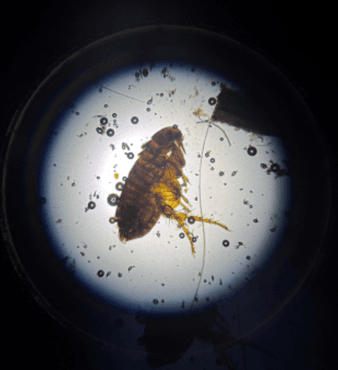
Despite the winter weather, the creepy-crawly parasites in the pet world persist.
Internal parasites were the topic of the first part of this education series, so this focus will be on external parasites.
On the outs
External parasites (also called ectoparasites) live on an animal rather than in an animal. A parasite is an organism that acquires its nutrition and/or vital life functions at the expense of another creature. Some cause little to no harm to their host, and others can cause significant harm. While there are several types of external parasites that can affect cats and dogs, this article will highlight a few of the most common ones seen at TCHS.
Fleas
Perhaps the most well-known external parasite seen infesting cats and dogs is the flea. Fleas bite their host and feed on their blood.
While there are specific species of “cat fleas” and “dog fleas,” the most common is the cat flea, which can affect cats and dogs. According to the Companion Animal Parasite Council, the cat flea is the most common ectoparasite of dogs in North America. The flea life cycle allows these creepy-crawly pests to excel in reproduction and survive in many conditions. Due to their life cycle and the widespread prevalence of fleas, year-round prevention is best.
In addition to the nuisance of itching and skin irritation, cats and dogs can have more serious side effects from fleas that can significantly harm overall health. Some complications include infectious disease, anemia, allergic reactions, tapeworms, and more.
Ticks
Often included in the conversation of flea prevention is another blood-sucking parasite: the tick!
Ticks are well known to many of us living in Central Minnesota due to human exposure to these pesky bugs. Like the concerns they pose to human health, there are a few infections that can be transmitted to pets through ticks.
Bacterial infections, such as Lyme disease and Anaplasmosis, are known as vector-borne illnesses. This means the pathogen requires a vector (carrier) to infect a person or animal. When a tick feeds on their host, there is potential to transmit these bacterial infections to the host they are feeding upon.
The sooner a tick is removed from its host, the lower the chance of transmitting potential infection. Even better than removing ticks right away is preventing them from attaching altogether, or decreasing the time they can attach by using safe preventative medications. A note on tick-borne illnesses such as Lyme disease: Though it can be disconcerting to learn your dog tests positive for one of these bacteria, it does not necessarily mean it will develop into active illness. The diagnoses, monitoring, and follow-up for positive exposure to tick-borne illness is a complex process and should be discussed with a veterinarian.
Lice
Many people are familiar with lice, especially if you have school-age children! Did you know that cats and dogs can also get lice?! One good thing about lice, though, is that they are species-specific. This means only “cat lice” can infest cats and only “human lice” can infest humans. So, if you find your cat or dog has lice, don’t panic. You won’t catch them.
But, lice are problematic to cats and dogs in a similar fashion that human lice are pesky. They are itchy, annoying, and can spread to others of the same species. Fortunately, many of the safe flea and tick products for cats and dogs also prevent lice.
Ear mites
The fourth and final ectoparasite we’ll cover is ear mites. While fleas, ticks, and lice can be found on the skin anywhere on an animal’s body, ear mites stay localized to the ears of their host. Ear mites are common, especially in cats. Once infested with ear mites, a cat or dog typically has very itchy and uncomfortable ears. Thick, dark debris builds up in the ear canals, and sometimes it can become so dense it may affect hearing. Many animals with ear mites scratch the backs of and insides of their ears to the point of causing additional wounds. While cats and dogs can spread ear mites to one another, it’s another one that humans don’t have to worry about catching. If you suspect a cat or dog has ear mites, consult a veterinarian.
Be wary
There are many safe products for use in cats and dogs to prevent these common external parasites. However, there are just as many unsafe options. Most over-the-counter treatments are not only minimally effective, but some can have serious side effects, including seizures and even death. Some ingredients that are used as pesticides cause significant neurological harm to animals. It’s not recommended to use over-the-counter treatments unless you’ve discussed it with your veterinarian. Although prescription products may cost slightly more upfront, they will often be more effective and much safer when used properly.
Additionally, some products labeled safe for dogs are not safe for cats. So even cats living in the same home as a dog who received a topical treatment may have safety risks if they make contact with the medication on the dog. Always consult with a veterinarian.
TCHS sells one of the safe over-the-counter flea and tick preventatives: Frontline for dogs and Frontline for cats.
Rose Hegerle is TCHS’ Director of Veterinary Services








